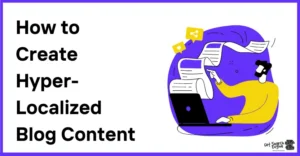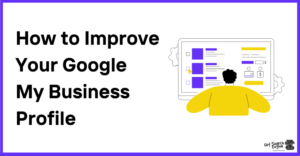Most local owners do the same dance: boost a post, try some Google Ads, print a flyer, then hope the phone rings. When it’s quiet, the answer is always “run more ads.” The problem isn’t effort; it’s the missing system.
A marketing funnel is that system, one simple path that moves strangers → leads → customers → loyal regulars.
In this guide, we’re not talking SaaS playbooks or 50-step automation trees. You’ll get a clear funnel map, with examples built for local business marketing: think dentists, gyms, salons, trades, and clinics. One framework you can sketch, run, and improve every month.
What Is a Marketing Funnel?
Let’s strip the jargon. What is a marketing funnel?
It’s a simple set of stages that move people from “never heard of you” to “repeat buyer and referrer.” That’s it. Awareness → Consideration → Purchase → Loyalty → Referral.
If you don’t have this, you’re stuck in random tactics, boosted posts, one-off discounts, and generic “brand campaigns.” That’s what a funnel is in marketing in practice: either you design the path, or you rely on luck and volume. Funnels win because they force you to answer three questions: how people find you, what convinces them, and what makes them come back.
Here’s the marketing funnel explained for a dentist:
- Top: Someone Googles “dentist near me” and sees your reviews and website.
- Middle: They check services, pricing cues, FAQs, and testimonials.
- Bottom: They book online or call; after the visit, they get a reminder and a review request; later, a check-up reminder.
Same person, different stages, different messages. The funnel is just you deciding what happens at each step, rather than leaving it to chance.
Stages of the Marketing Funnel
Forget acronyms for a second. The core marketing funnel stages are:
- Top of funnel (TOFU) – Aware
Goal: get on the radar.
Message: “We exist and we solve this problem near you.”
Channels: Google search, GBP, local SEO, social, and local sponsors.
Offline outcome: more people discovering your name and offers. - Middle of funnel (MOFU) – Consider
Goal: build trust and answer doubts.
Message: “Here’s why we’re the right choice for you.”
Channels: service pages, FAQs, reviews, emails, DMs, chat.
Offline outcomes: more quotes requested, more questions asked, and stronger intent signals. - Bottom of funnel (BOFU) – Decide
Goal: get the yes.
Message: “Book here, at this time, with this offer.”
Channels: booking pages, calls, SMS, WhatsApp, and in-person follow-up.
Offline outcome: calls, bookings, walk-ins, and signed contracts.
After that, add Retention & Advocacy to the stages of the marketing funnel: reminders, reactivation offers, review, and referral asks. The real test of any stage of the marketing funnel model for local businesses isn’t clicks, it’s whether more people show up, come back, and send friends.
Top of Funnel Marketing for Local Businesses
Top of funnel marketing is about one thing: making sure people in your area know you exist before they need you. For local small business marketing, that starts with Local SEO and your Google Business Profile (GBP): complete categories, real photos, tight descriptions, and consistent NAP. Add local directories (niche sites, chambers, review platforms) so you show up wherever people search.
Layer simple awareness ads: radius-based Google Ads on core services, Meta/Instagram ads with “near you” angles, maybe Waze/Maps placements if relevant. Don’t forget offline: sponsorships, local events, and partnerships with nearby businesses all feed the same top-of-the-funnel marketing goal, name recognition.
Content at this stage should be quick and local: 30–45 second videos, “how it works” reels, neighborhood guides, seasonal tips. Think of it as the top layer of your content marketing funnel, useful, not salesy.
Measure TOFU with impressions, clicks, and branded search lift (more people Googling your name). If those aren’t moving, nothing further down the funnel will scale.
Middle of the Marketing Funnel
This is where marketing funnels usually fall apart for local businesses. People click, poke around, then leave because there’s nothing that actually answers their questions or asks for the next step.
Start with assets: clear service pages (who it’s for, what you do, price cues, how it works), skimmable FAQs, short case studies (“before/after” stories), testimonials with names and locations, and simple comparison pages (“Why choose us vs X / DIY?”). This is the heavy-lifting layer of your content marketing funnel.
Then capture the lead. Add simple forms (“Request a quote,” “Book a free consult”), chat/DM options, and one main CTA per page. Ask for the minimum info you need: name, contact, and intent. For higher-ticket services, offer a light lead magnet, pricing guides, prep checklists, or “what to expect” PDFs, delivered via email as the start of a basic email marketing funnel.
Keep it local: “Moving to [City] checklist,” “First-time buyer guide for [Area],” “What to know before choosing a [service] in [City].” The goal at MOFU isn’t to close everyone; it’s to turn anonymous visitors into identified leads who trust you enough to talk.
Bottom of Funnel Marketing
This is where bottom-of-funnel marketing earns its keep. Leads already know you; now they’re choosing who to go with and when. Your tools here are offers, follow-up, and friction removal.
Offers first. Think in real-world terms: trials, first-visit discounts, bundles (“family package,” “season pass”), payment plans, and guarantees (“no fix, no fee,” “love it or it’s free to adjust”). Position them for locals: limited slots this week, specific days, or neighborhood-only promos. Make the offer visible in emails, SMS, and on booking pages, not buried in a PDF.
Then the handoff. A working marketing and sales funnel for local businesses is usually marketing → front desk or owner. That means every lead gets logged, tagged (service, urgency), and followed up via email/SMS/call. Missed calls trigger text-back. Quotes get a reminder. Bookings get confirmations and pre-visit info.
Track BOFU with a basic sales marketing funnel view: lead-to-booking rate, time-to-book, show-up rate, and sale value. Slice by source (GBP, ads, referrals) and offer. If TOFU and MOFU look healthy but revenue is flat, the problem is here: weak offers, slow follow-up, or messy scheduling. Fix this layer before buying more traffic.
Beyond the Marketing Funnel
Once someone buys, your job shifts from selling to staying relevant. A digital marketing funnel that stops at “new customer” is leaving easy money on the table. Keep it simple: send reminders (check-ups, renewals, seasonal services), quick check-ins (“How did it go?”), and reactivation offers for people who’ve gone quiet.
Referrals are your cheapest growth. Ask for reviews after good experiences, with a direct link to GBP. Layer in referral incentives (“Give $20, get $20,” “Free class when a friend joins”) and basic loyalty programs (stamp cards, visit-based perks).
You don’t need enterprise tools to run marketing funnel automation. Set up a few email/SMS sequences: post-visit review request, rebook reminder at the right interval, win-back message for lapsed customers. Use simple CRM tags (new, active, lapsed, VIP) and trigger messages off those. The goal isn’t complexity; it’s staying top-of-mind until they need you again, and making it easy to send friends.
Funnels for Local Business
Let’s make this real with funnels for local businesses you can steal.
1) Service provider: plumber (classic sales funnel for local business)
- Channels (TOFU): “emergency plumber near me” search, GBP, local ads.
- Visit (MOFU): service page with clear pricing ranges, response time, FAQs, and reviews.
- Offer (BOFU): “We’re there in under 90 minutes or 10% off,” online booking + click-to-call.
- Follow-up: post-job SMS review request, 6-month maintenance reminder.
High-leverage tweaks:
- Missed-call text-back (“Saw you called, need help now?”).
- Simple “estimate request” form feeding a shared inbox.
This is a sales funnel for a local business where every step pulls toward a booked job.
2) Brick-and-mortar: gym (walk-in focused local business sales funnel)
- Channels (TOFU): local reels/TikToks, GBP photos, “gym near [area]” SEO.
- Visit (MOFU): landing page with class schedule, pricing tiers, and real member stories.
- Offer (BOFU): “7-day free pass” or “$1 first class,” instant pass via SMS/email.
- Follow-up: day 3 check-in, day 7 “join now” offer, monthly progress nudges.
High-leverage tweaks:
- Online waiver + pass, so the front desk just checks a code.
- Auto reminder one hour before class/visit.
These marketing funnel examples are simple on purpose: one main channel, one clear offer, and a tight follow-up loop. Get this working before you add complexity.

Digital Marketing Funnel for Local Businesses
A good digital marketing funnel doesn’t mean “be on every platform.” It means picking the right channels for each stage and making them work together.
- Top (Aware): Local SEO, GBP, and basic paid search are non-negotiable for digital marketing for local businesses. Add simple Meta/Instagram awareness ads and short-form social if you have capacity. This is the “find us” layer of online marketing for local businesses.
- Middle (Consider): Your site, service pages, reviews, and email do the heavy lifting. Retargeting ads and DMs answer objections. Here, digital marketing for local businesses is about proof, results, stories, and FAQs.
- Bottom (Decide): Booking tools, SMS/WhatsApp, and phone follow-up close the loop. This is where local business digital marketing overlaps with operations: clear offers, easy scheduling, fast replies.
- After (Retain/Refer): Email/SMS sequences, occasional social check-ins, and review requests keep you top-of-mind.
The point of a digital marketing funnel for a local digital marketing business setup is one journey: channel → page → offer → follow-up. Start narrow: 1–2 channels per stage, you can execute well. Master those before you add anything else.
Full Funnel Marketing Strategy
For locals, full funnel marketing just means this: awareness → consideration → conversion → loyalty → referral, all working as one system. Not “we did some Google Ads,” “we boosted a post,” and “we printed flyers” with no connection.
Stack your activities instead of running siloed campaigns:
- Awareness: Local SEO, GBP, light paid search, simple social.
- Consideration: strong service pages, FAQs, testimonials, comparison pages.
- Conversion: clear offers, online booking, fast follow-up via SMS/call.
- Loyalty/Referral: reminders, review requests, referral incentives.
A practical full funnel marketing strategy checklist:
- Define 1–2 KPIs per stage (e.g., calls, bookings, repeat visits).
- Map stages to channels and pages.
- Write one key message and one main offer per stage.
- Set concrete follow-ups (who contacts leads, how, and when).
- Review monthly: what moved, what stalled, what to kill.
That’s funnel marketing in the real world: fewer tactics, more intent. If an activity doesn’t fit a stage, it doesn’t fit your funnel marketing strategy.
Marketing Funnel Software and Automation for Local Teams
You don’t need enterprise tools to run a clean funnel. A lightweight stack is enough: a website/booking tool, a simple CRM or lead tracker, an email/SMS platform, and basic reporting (GSC, GA4, ad accounts). That’s your core marketing funnel software.
Use marketing funnel software to automate the boring but critical stuff: appointment reminders, quote follow-ups, “thanks for visiting” messages, and review requests. Trigger flows from real events, new leads, booking confirmed, visit completed, no-show, and lapsed customers.
Don’t overbuild. Start with email marketing funnel basics plus a few SMS automations:
- New lead → “here’s what happens next” sequence.
- Post-visit → review ask + referral nudge.
- Lapsed customer → simple “we’d like to see you again” offer.
That’s effective marketing funnel automation for a local team: a handful of reliable, revenue-linked flows instead of a spaghetti mess of tags and journeys nobody remembers.
SEO, SaaS, and Ecommerce Marketing Funnels (How They Differ)
An SEO marketing funnel leans on content and organic search to move people from questions to intent to action, blogs, guides, comparison pages, and then service/booking pages. A digital marketing sales funnel for ads-heavy businesses pushes harder on paid channels (search, social, retargeting) and tracks CAC/ROAS much more closely.
A saas marketing funnel adds trials, demos, and product-led onboarding. An e-commerce marketing funnel focuses on product pages, cart recovery, and LTV via email/SMS offers.
For you as a local business, these are reference models, not blueprints. Borrow their good parts (educational content from SEO, retargeting from ecommerce, trials from SaaS), but keep your funnel grounded in offline outcomes: calls, bookings, foot traffic, and repeat visits.
How to Create a Local Business Funnel That Actually Works?
Here’s how to create a local business funnel in plain English:
- Pick 1–2 KPIs per stage of your marketing funnel (calls, bookings, repeat visits).
- Map stages (aware → consider → book → return → refer) and choose 1–2 tactics/channels per stage.
- Set simple follow-ups (who contacts leads, how, and when) and review monthly.
Treat this as your operating system for marketing for local businesses, your ongoing local business marketing solutions, not a one-off campaign.
Frequently Asked Questions
A marketing funnel for local businesses is a simple path that moves people from “never heard of you” to “loyal regular.” In practice, it’s how you design each stage of local business marketing, awareness, consideration, booking, and repeat visits, instead of jumping between random ads and posts.
It’s a way to organize your efforts into stages: top (get discovered), middle (build trust), bottom (close), then retain/referral. For local small business marketing, it matters because it links your spend (SEO, ads, email) to real outcomes: calls, bookings, and foot traffic.
For most local businesses, the core marketing funnel stages are:
1. Top of funnel: get found via Local SEO, GBP, and digital marketing for local business (search/social).
2. Middle: use service pages, reviews, and emails to answer questions.
3. Bottom: clear offers and easy booking.
Layer loyalty and referrals once that works.
You can build a simple sales funnel for local business with just a website/booking tool, email/SMS, and a basic CRM sheet.
Map “clicks → leads → bookings → repeat visits,” then add 2–3 follow-ups at each step.
Most funnels for local businesses fail from no follow-up, not lack of software.
A basic digital marketing funnel could be:
Google search ad → location page with reviews → “Book now” online → SMS confirmation → post-visit review request → 3-month check-in.
That’s digital marketing for local businesses done right: every channel and touchpoint pushing toward one goal, more paying, returning customers.





Leave a Reply